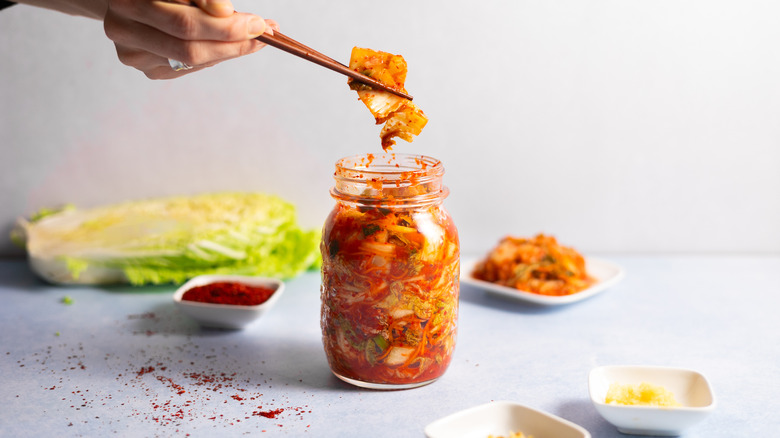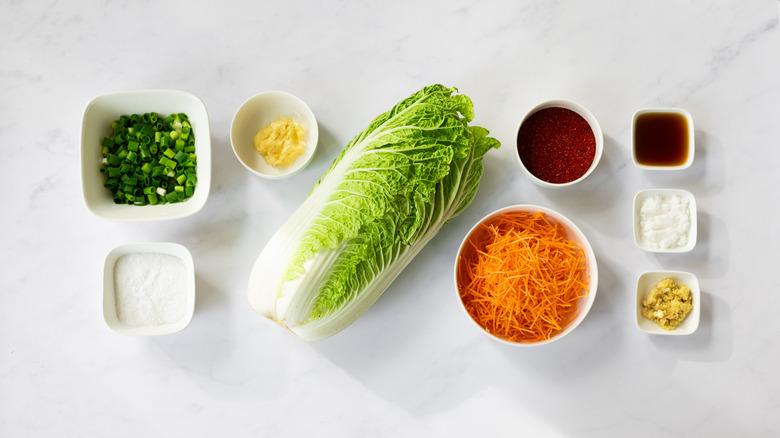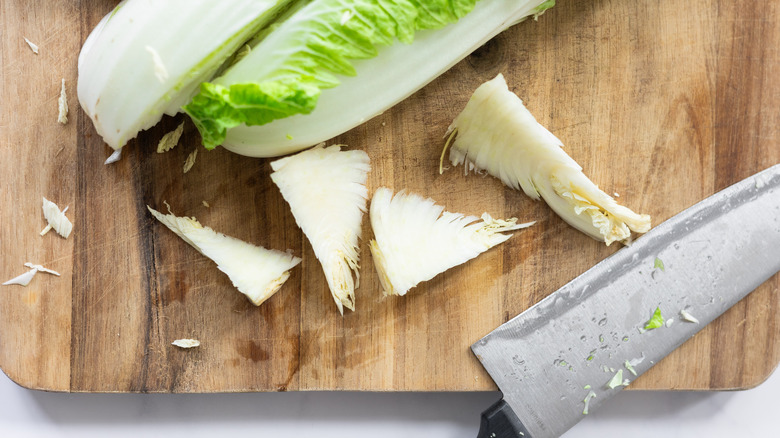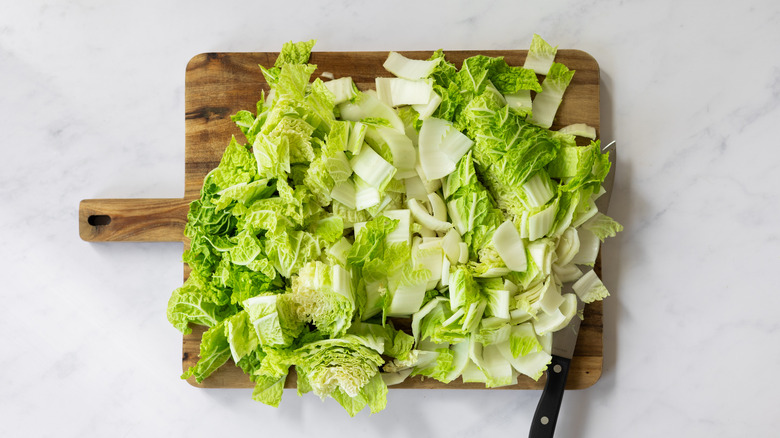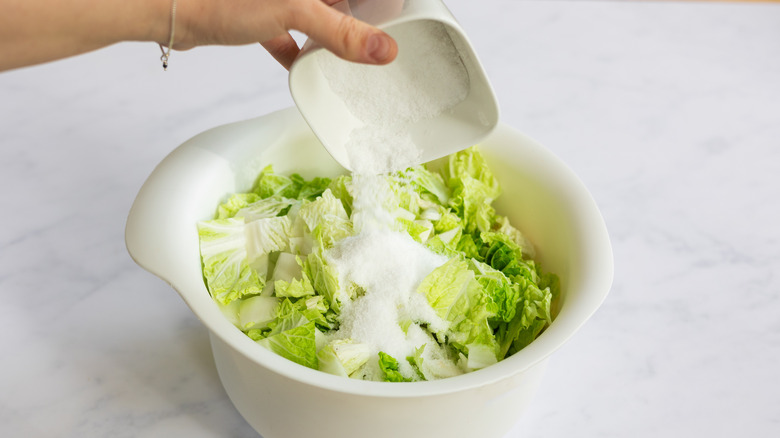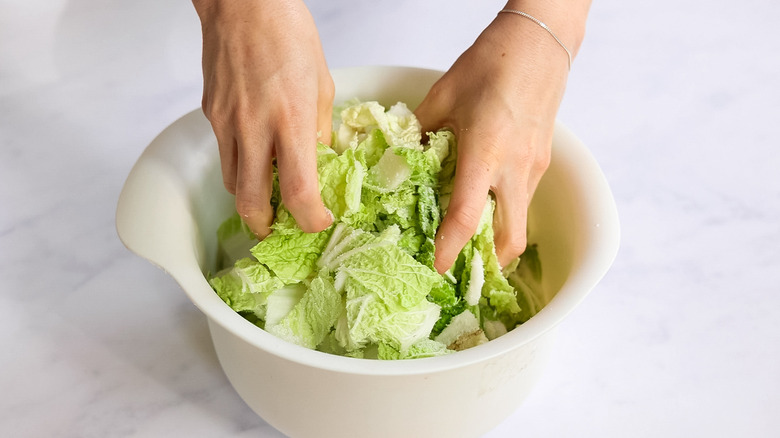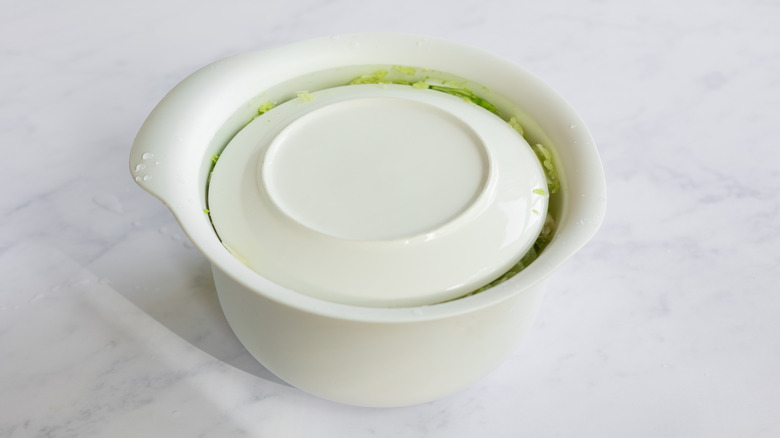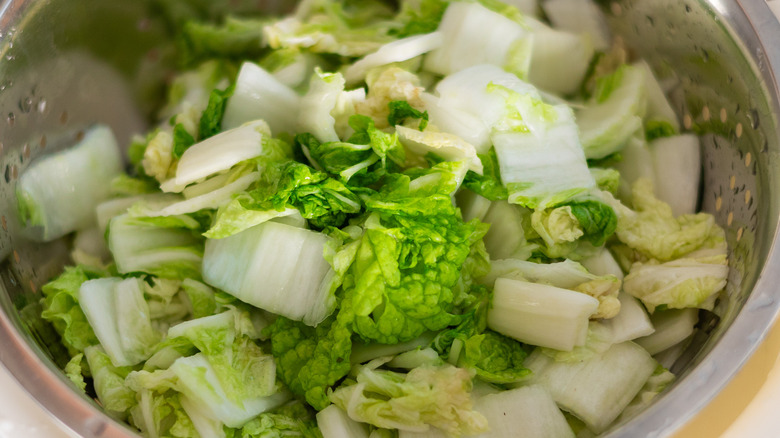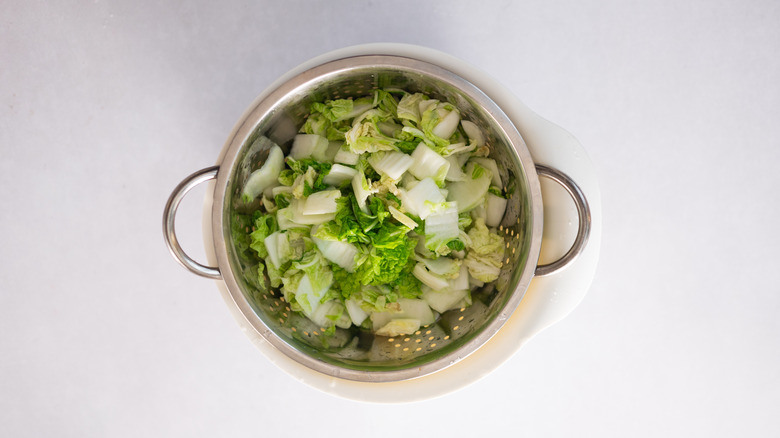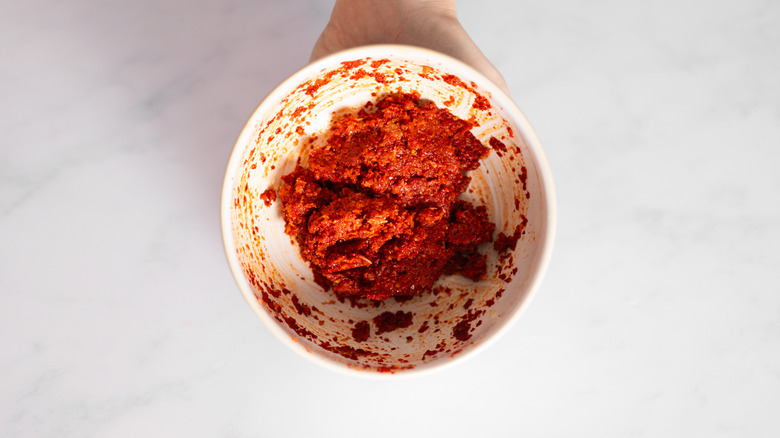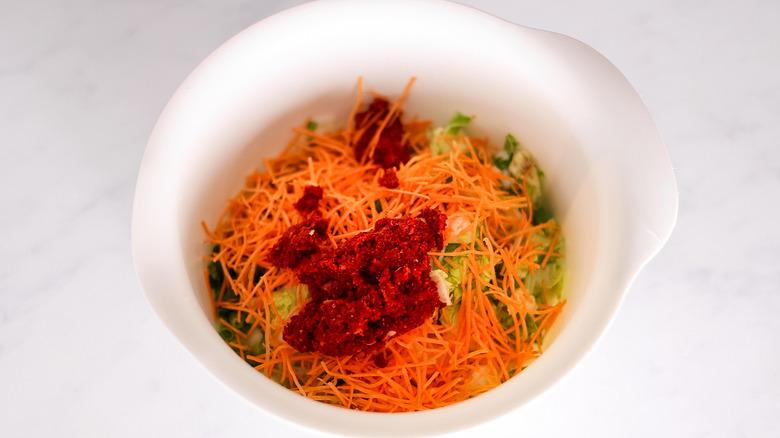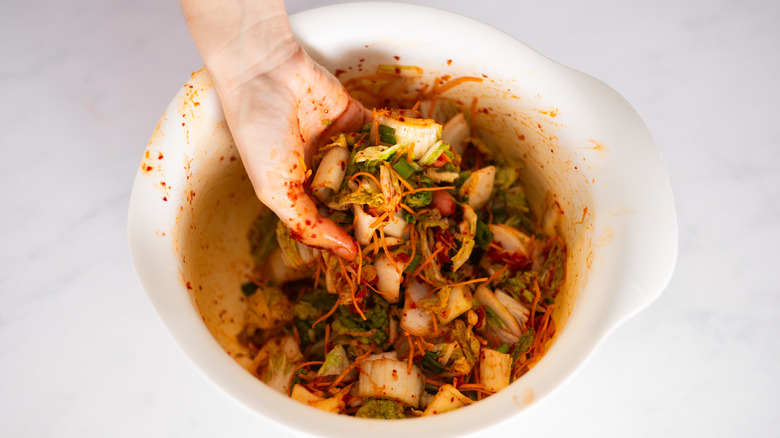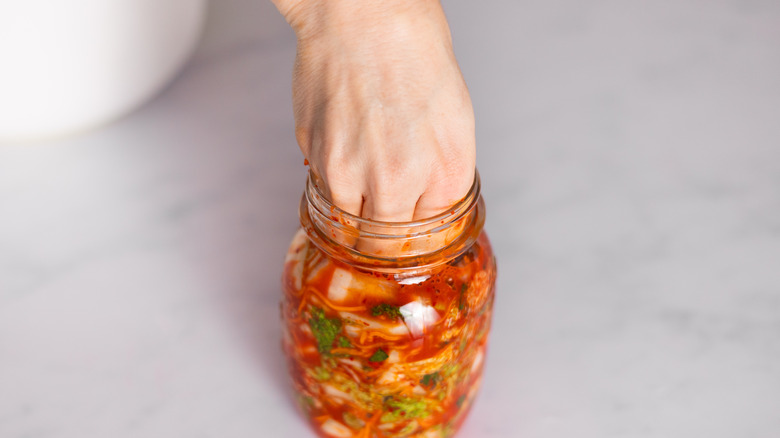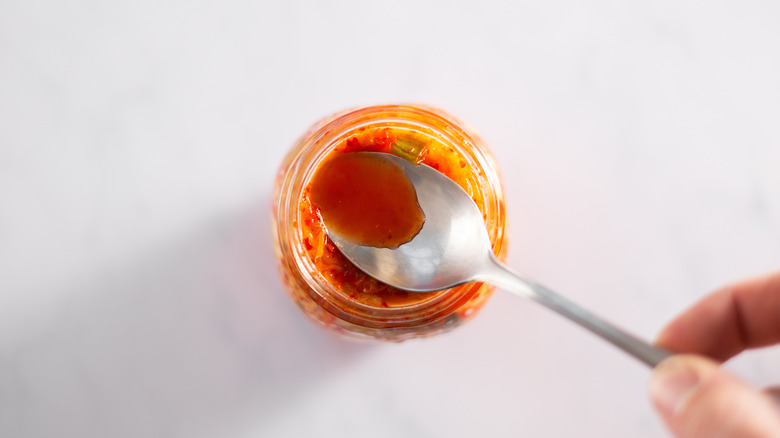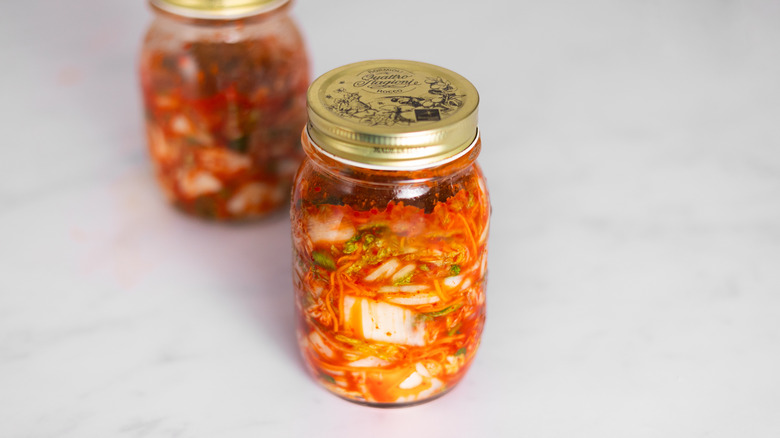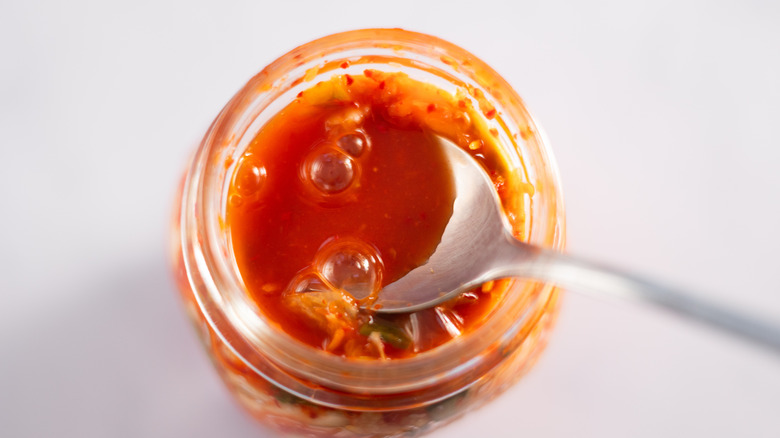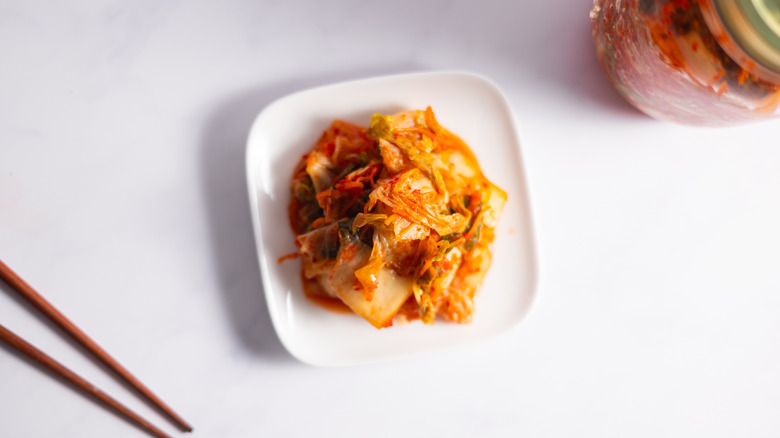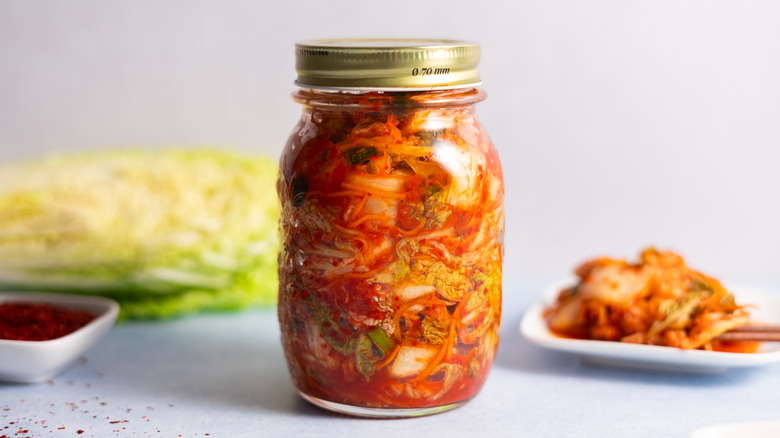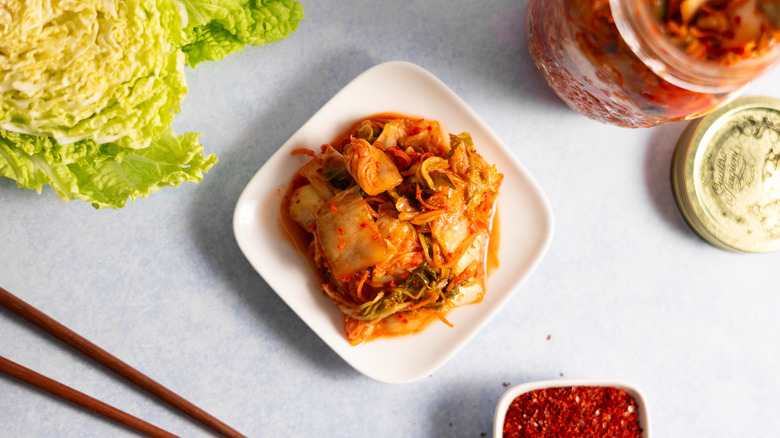Classic Napa Cabbage Kimchi Recipe
Kimchi's bold flavors have captivated the taste buds of many around the world for millennia. This classic Napa cabbage kimchi from recipe developer Tanika Douglas strikes the perfect balance between spicy, sour, and umami; it's an irresistible accompaniment to a wide array of meals and can even be eaten on its own as an appetizer. This recipe guides you through the art of crafting your own homemade Napa cabbage kimchi. Kimchi, deeply rooted in Korean tradition, is not just a condiment — it celebrates the process of fermentation. This recipe ensures that you experience the authentic flavors and processes of this beloved dish. The best part is that you can easily make it in your own kitchen.
With just three hours of preparation and a little patience for fermentation, you'll find yourself with two 16-ounce jars brimming with deliciousness. The star of the show is undoubtedly the Napa cabbage itself, whose crisp, leafy layers absorb the vibrant flavors of the marinade. Douglas says, "The fermentation process is crucial in developing that quintessential kimchi tang. Over the course of three days, the kimchi will undergo a fascinating transformation as the flavors meld and bubbles form around the cabbage, indicating that it's fermenting beautifully. Then, it's time to enjoy your homemade kimchi that's bursting with a delightful blend of texture and spicy, umami flavor." In our fast-paced world, this classic Napa cabbage kimchi recipe offers a reminder that the most satisfying condiments often require a touch of patience and plenty of tradition.
Gather the ingredients for the classic Napa cabbage kimchi
To prepare this delicious, fermented Korean condiment, you will need Napa cabbage, minced garlic cloves, grated ginger, gochugaru red chili flakes, peeled and julienned carrot, sliced scallions, sugar, fish sauce, water, and salt. Napa cabbage is a long, large variety of cabbage with crisp, pale green and white leaves. To ensure you create the perfect kimchi, it is essential that you source a fresh, firm Napa cabbage.
Gochugaru red chilli flakes add an invigorating spicy kick to the kimchi and impart the condiment's beautiful, vibrant, red-orange hue. Gochugaru can be found in most Asian grocers and is different from regular chilli flakes, as it is more finely processed and offers a more potent kick. "While 2 tablespoons of gochugaru red chilli flakes are used within this Napa cabbage kimchi recipe, the quantity can be adjusted depending on your personal spice preference. With this particular amount, the spice level is moderate, and it provides a lovely balance of fiery spice and flavor without overtaking the other flavors within the kimchi," Douglas says.
Step 1: Quarter the cabbage
Slice the cabbage into quarters lengthwise, then remove the hard cores.
Step 2: Chop the cabbage
Chop the cabbage into 1-inch slices.
Step 3: Salt the cabbage
Place the cabbage into a large bowl and add the salt.
Step 4: Massage the cabbage
Mix and massage the salt into the cabbage.
Step 5: Allow the cabbage to sit
Cover the cabbage with water and top with a heavy plate to weigh the cabbage down. Set the cabbage aside to sit for 2 ½ hours.
Step 6: Drain and rinse the cabbage
Drain the water from the cabbage, then rinse five times to remove the salt water.
Step 7: Allow the cabbage to drain
Allow the cabbage to sit in the colander and drain for 25 minutes.
Step 8: Prepare the spice paste
Mix together the minced garlic, grated ginger, gochugaru, sugar, fish sauce, and water.
Step 9: Combine the vegetables
Place the cabbage into a large, dry bowl and add the julienned carrot, sliced scallions, and the spice paste from step 8.
Step 10: Mix the kimchi
Mix thoroughly with your hands until each piece of cabbage is coated with the spice paste.
Step 11: Pack the kimchi into the jars
Pack the kimchi mixture into two 16-ounce jars.
Step 12: Press the kimchi down
Press the mixture down to ensure that the brine rises to the surface and covers the cabbage. Leave a 1-inch air gap at the top of each jar.
Step 13: Let the kimchi ferment
Let the kimchi ferment for three days at room temperature and away from sunlight.
Step 14: Open the kimchi daily
Open the kimchi daily, and use a clean spoon to press the cabbage back down under the brine. Bubbles should have formed around the cabbage, which means it has fermented nicely.
Step 15: Refrigerate and serve the kimchi
Place the kimchi in the fridge for two days to allow the flavors to further develop, then enjoy.
What are common mistakes to avoid when making Napa cabbage kimchi?
Making kimchi can be a rewarding culinary endeavor, but it's essential to steer clear of common mistakes to ensure that your creation turns out as delicious as intended. For example, failing to salt the cabbage adequately can result in overly watery kimchi. As cabbage is packed with water, the salt is essential for drawing moisture out and creating the perfect brine for fermentation. Proper cleanliness is also essential when making kimchi or in the fermentation process of any food. Failing to use clean utensils, jars, and hands can introduce unwanted bacteria and potentially spoil your batch. Always use a clean spoon when serving the kimchi.
When packing kimchi into jars, it's important to press it down firmly to ensure that the brine rises to the surface and covers the cabbage. Leaving an inch of air at the top of the jar is vital to prevent spoilage and create an anaerobic environment that encourages fermentation. Finally, fermentation is the most important part of the kimchi, and it's integral to not rush this step. Douglas says, "Allowing your kimchi to ferment for the full amount of time at room temperature is essential for developing the desired flavors and textures. Rushing this process may result in underdeveloped kimchi that lacks the unique, zingy tang that kimchi is known for." Follow these steps and you will be well on your way to stocking your fridge with irresistible, spicy kimchi.
What ways can I use Napa cabbage kimchi?
Serving kimchi is an art in itself, and there are numerous, delicious ways to enjoy this iconic Korean dish. Kimchi is traditionally served as a side dish in Korean cuisine. Its bold and zingy flavors make it an excellent accompaniment to a variety of recipes. Simply place a small portion of kimchi in a small dish to be enjoyed alongside rice, grilled meats, or stir-fried dishes.
If you are inspired to use the Napa cabbage kimchi within a recipe, there are many dishes that shine a light on kimchi and highlight its beautifully unique, umami flavor. Douglas says, 'Kimchi Bokkeumbap, or kimchi fried rice, is a quick and incredibly simple dish where chopped kimchi is stir-fried with rice and accompanied by vegetables, protein, and seasonings. Another well-loved Korean favorite is Kimchi Jjigae, a comforting and hearty soup made with kimchi, tofu, and other ingredients like pork or seafood. It has a deep, rich, spicy, and sour broth that's perfect for warming up on a cold day. Additionally, Kimchijeon, or kimchi pancakes, are savory Korean pancakes made with kimchi and a simple batter. They're crispy on the outside and tender on the inside; they are a delightful snack or appetizer."
Whilst these are only a few of the many, wonderful ways to use serve kimchi, adding it to simple dishes such as avocado toast, mac and cheese, and omelets can elevate the meal by adding a lovely, umami tang!
Classic Napa Cabbage Kimchi Recipe
Kimchi, the iconic side dish of Korean cuisine, is less daunting to make at home than you may think. This recipe is your ticket to spicy, fermented goodness.
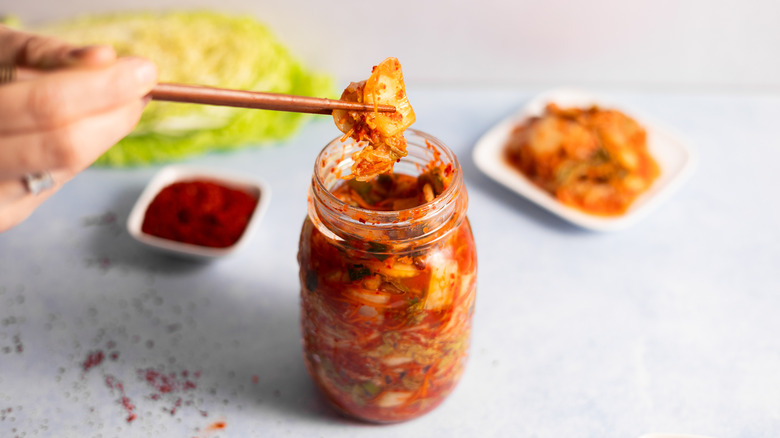
Ingredients
- 1 Napa cabbage
- ½ cup salt
- 7 cloves garlic, minced
- 3 teaspoons grated ginger
- 2 tablespoons gochugaru red chili flakes
- 1 tablespoon sugar
- 3 tablespoons fish sauce
- 1 tablespoon water
- 2 cups peeled and julienned carrot
- 5 scallions, sliced
Directions
- Slice the cabbage into quarters lengthwise, then remove the hard cores.
- Chop the cabbage into 1-inch slices.
- Place the cabbage into a large bowl and add the salt.
- Mix and massage the salt into the cabbage.
- Cover the cabbage with water and top with a heavy plate to weigh the cabbage down. Set the cabbage aside to sit for 2 ½ hours.
- Drain the water from the cabbage, then rinse five times to remove the salt water.
- Allow the cabbage to sit in the colander and drain for 25 minutes.
- Mix together the minced garlic, grated ginger, gochugaru, sugar, fish sauce, and water.
- Place the cabbage into a large, dry bowl and add the julienned carrot, sliced scallions, and the spice paste from step 8.
- Mix thoroughly with your hands until each piece of cabbage is coated with the spice paste.
- Pack the kimchi mixture into two 16-ounce jars.
- Press the mixture down to ensure that the brine rises to the surface and covers the cabbage. Leave a 1-inch air gap at the top of each jar.
- Let the kimchi ferment for three days at room temperature and away from sunlight.
- Open the kimchi daily, and use a clean spoon to press the cabbage back down under the brine. Bubbles should have formed around the cabbage, which means it has fermented nicely.
- Place the kimchi in the fridge for two days to allow the flavors to further develop, then enjoy.
Nutrition
| Calories per Serving | 131 |
| Total Fat | 1.4 g |
| Saturated Fat | 0.2 g |
| Trans Fat | 0.0 g |
| Cholesterol | 0.0 mg |
| Total Carbohydrates | 28.6 g |
| Dietary Fiber | 6.1 g |
| Total Sugars | 14.6 g |
| Sodium | 2,217.9 mg |
| Protein | 4.6 g |
